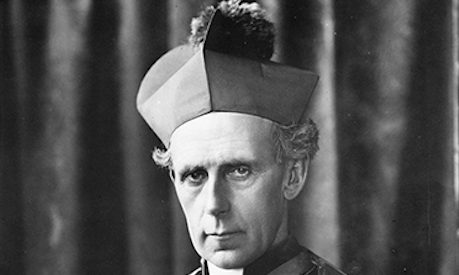Fourteen Australian recipients of the highest Commonwealth military honour, the Victoria Cross, are mounted on grey chargers.
They lead the carriage of the Irish-born Archbishop of Melbourne, Daniel Mannix, along Bourke Street in Melbourne.
Around 10,000 first world war veterans and throngs of Catholic schoolboys march behind the procession while tens of thousands of Melburnians line the streets and cheer them on.
It is Saturday 20 March 1920.
This special St Patrick’s Day parade (three days after the calendar marks the actual commemoration for Ireland’s patron saint) is being made into a silent film by Bert Cross, a cinematographer who’ll find fame in 1927 for adapting to film Marcus Clarke’s novel For the Term of his Natural Life.
But Cross is almost incidental to the film – Ireland Will be Free – he is shooting this day.
Indeed, when you look at the film, which has been restored by the National Film and Sound Archive before its first full screening in almost a century this Friday, it is obvious the true directors are before, not behind, the camera.
They are Mannix and his perhaps unlikely friend and confidant John Wren, a man whose contradictions (shunned by the establishment while a puppeteer of politicians; illegal bookmaker-cum-millionaire who never lost touch with his Collingwood slum roots; a supporter of the church who only formally worshipped late in life, and a staunch Irish republican who unequivocally supported the Empire’s war from the outset) put him at odds with easy definition.
The common, enduring epithet “colourful Melbourne identity” undermines Wren’s complexities.
Amid the fierce sectarianism that engulfed Australia during and just after the war, Mannix – archbishop from 1917 to 1963 – made the film as a testimony to his support for an Irish free state. Mannix, born in County Cork in 1864, a life-long republican and later confidant to the Irish Taoiseach (prime minister) Éamon de Valera, supported Britain’s declaration of war in late 1914.
But in 1915, when sectarianism became a potent undercurrent of Australian society amid false suggestions that Irish Catholics were not volunteering to fight in sufficient numbers, Mannix’s opposition to war grew. Continue reading
Sources
- Guardian Australia, from an article by Paul Daley, who writes about Indigenous history, Australian culture and national identity for Guardian Australia.
- Image: National Museum Australia
Additional reading
News category: Features.




